


Fort Point is a neighborhood or district of Boston, Massachusetts, and where a fort stood which guarded the city in colonial times.



Fort Point is a neighborhood or district of Boston, Massachusetts, and where a fort stood which guarded the city in colonial times.
Fort Hill was located near what is today the intersection of Oliver and High Streets. At least until 1675, (see map) the hill jutted out into the Atlantic Ocean, hence the designation of being a "point". Its height and proximity to the sea made the hill an advantageous point to put defensive cannons. Between 1866 and 1872, the City of Boston undertook a redevelopment project on Fort Hill in attempt to add more land for business facilities. The project called for the Hill to be leveled, for the streets to be widened, and for all buildings to be razed. [1] [2] Today the land is flat and largely occupied by the towers of International Place. Landfill has also extended the shoreline outward, so the location of the old fort is no longer directly on the waterfront.
The boundaries of the modern neighborhood of Fort Point are somewhat ill-defined. At its broadest extent, it includes the land a few blocks on either side of the Fort Point Channel (which due to landfill is considerably smaller than it was in colonial times). The Fort Point artists' community [3] is located on the opposite side of the channel. This is also called the South Boston Waterfront. Real estate listings include "Fort Point" locations east of the channel and west of the Boston Convention and Exhibition Center and the Boston World Trade Center. (Further south is South Boston proper.) The Boston Redevelopment Authority defines the Fort Point District within the neighborhood of South Boston as "an area of approximately 100 acres (0.40 km2) defined by the Fort Point Channel to the west, Summer Street to the north, the Bypass Road to the east, and West 2nd Street to the south." [4]
The Summer Street Bridge, which crosses the channel, has a sign which welcomes eastbound travelers to South Boston, and westbound travelers to Fort Point. The United States Postal Service Bulk Mail Center at Fort Point Station is located between the channel and South Station. To the northwest is Chinatown. The northeastern section of the Fort Point neighborhood, on the east side of the channel, could be said to overlap with the Financial District.
The Fort Point neighborhood was featured in Martin Scorsese's 2006 film The Departed . An alley between Thompson Place and Farnsworth Street provided the setting for the fictional address "344 Wash." The dramatic views of downtown Boston from the rooftops of Fort Point were prominently featured in the film.
In 2001, the Fort Point District was petitioned [5] as a Landmark District with the Boston Landmarks Commission. [6] In 2007, a Mayoral-appointed Study Committee began drafting District guidelines. In December 2008, Mayor Menino and the Boston Landmarks Commission voted in favor of the guidelines which were officially approved on January 28, 2009 by the Boston City Council. [7]
Fort Point is served by the Massachusetts Bay Transportation Authority via Broadway station and South Station as well as bus routes #7, #9, #11 and #47. The Silver Line (MBTA) bus rapid transit (BRT) system serves parts of Fort Point. Several water taxi companies serve Fort Point locations along Fort Point Channel such as Atlantic Wharf, Children's Wharf and the John Joseph Moakley United States Courthouse/Fan Pier connecting to Rowes Wharf and Logan International Airport.
With the rapid growth of Fort Point, private shuttles have supplemented public transportation to the neighborhood. The Southie Shuttle, Cultural Connector and Channel Center Shuttle are some of the private transportation services.
In 2013, plans were announced that diesel rail service would connect the South Boston Waterfront to Back Bay. [8]

Charlestown is the oldest neighborhood in Boston, Massachusetts, in the United States. Also called Mishawum by the Massachusett, it is located on a peninsula north of the Charles River, across from downtown Boston, and also adjoins the Mystic River and Boston Harbor waterways. Charlestown was laid out in 1629 by engineer Thomas Graves, one of its earliest settlers, during the reign of Charles I of England. It was originally a separate town and the first capital of the Massachusetts Bay Colony.
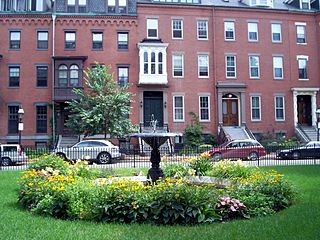
The South End is a neighborhood in Boston, Massachusetts, which is bordered by Back Bay, Chinatown, and Roxbury. It is distinguished from other neighborhoods by its Victorian-style houses and the parks in and around the area. The South End is the largest intact Victorian row-house district in the country, covering over 300 acres (120 ha). It has eleven residential parks. In 1973, the South End was listed on the National Register of Historic Places. Much of the neighborhood was originally marshlands in Boston's South Bay. After it was filled in, construction began in 1849.

The North End is a neighborhood of Boston, Massachusetts. It has the distinction of being the city's oldest residential community, which has been inhabited since it was colonized in the 1630s. It is only 0.36 square miles (0.93 km2), yet the neighborhood has nearly one hundred establishments and a variety of tourist attractions. It is known for its Italian American population and Italian restaurants.

The Silver Line is a system of bus routes in Boston and Chelsea, Massachusetts, operated by the Massachusetts Bay Transportation Authority (MBTA). It is operated as part of the MBTA bus system, but branded as bus rapid transit (BRT) as part of the MBTA subway system. Six routes are operated as part of two disconnected corridors. As of 2019, weekday ridership on the Silver Line was 39,000.

Downtown Pittsburgh, colloquially referred to as the Golden Triangle, and officially the Central Business District, is the urban downtown center of Pittsburgh, Pennsylvania, United States. It is located at the confluence of the Allegheny River and the Monongahela River whose joining forms the Ohio River. The triangle is bounded by the two rivers.

Southwest is the southwestern quadrant of Washington, D.C., the capital of the United States, and is located south of the National Mall and west of South Capitol Street. It is the smallest quadrant of the city, and contains a small number of named neighborhoods and districts, including Bellevue, Southwest Federal Center, the Southwest Waterfront, Buzzard Point, and the military installation known as Joint Base Anacostia–Bolling.

North Station is a commuter rail and intercity rail terminal station in Boston, Massachusetts. It is served by four MBTA Commuter Rail lines – the Fitchburg Line, Haverhill Line, Lowell Line, and Newburyport/Rockport Line – and the Amtrak Downeaster intercity service. The concourse is located under the TD Garden arena, with the platforms extending north towards drawbridges over the Charles River. The eponymous subway station, served by the Green Line and Orange Line, is connected to the concourse with an underground passageway.
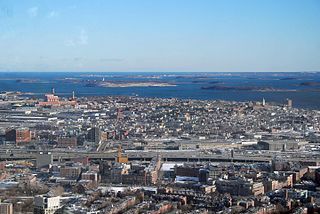
South Boston is a densely populated neighborhood of Boston, Massachusetts, located south and east of the Fort Point Channel and abutting Dorchester Bay. South Boston, colloquially known as Southie, has undergone several demographic transformations since being annexed to the city of Boston in 1804. The neighborhood, once primarily farmland, is popularly known by its twentieth century identity as a working class Irish Catholic community. Throughout the twenty-first century, the neighborhood has become increasingly popular with millennial professionals.

The Embarcadero is the eastern waterfront of Port of San Francisco and a major roadway in San Francisco, California. It was constructed on reclaimed land along a three mile long engineered seawall, from which piers extend into the bay. It derives its name from the Spanish verb embarcar, meaning "to embark"; embarcadero itself means "the place to embark." The Central Embarcadero Piers Historic District was added to the National Register of Historic Places on November 20, 2002.

The Rose Fitzgerald Kennedy Greenway is a linear park located in several Downtown Boston neighborhoods. It consists of landscaped gardens, promenades, plazas, fountains, art, and specialty lighting systems that stretch over one mile through Chinatown, the Financial District, the Waterfront, and North End neighborhoods. Officially opened in October 2008, the 17-acre Greenway sits on land created from demolition of the John F. Fitzgerald Expressway as part of the Big Dig project.
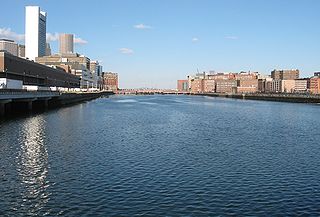
Fort Point Channel is a maritime channel separating South Boston from downtown Boston, Massachusetts, feeding into Boston Harbor. The south part of it has been gradually filled in for use by the South Bay rail yard and several highways. At its south end, the channel once widened into South Bay, from which the Roxbury Canal continued southwest where the Massachusetts Avenue Connector is now. The Boston Tea Party occurred at its northern end. The channel is surrounded by the Fort Point neighborhood, which is also named after the same colonial-era fort.

Seaport Village is a waterfront shopping and dining complex adjacent to San Diego Bay in downtown San Diego, California. It is located at 849 West Harbor Drive, at the intersection of Harbor Drive and Kettner.

Boston's diverse neighborhoods serve as a political and cultural organizing mechanism. The City of Boston's Office of Neighborhood Services has designated 23 Neighborhoods in the city:

Courthouse station is an underground bus rapid transit station on the MBTA's Silver Line, located under Seaport Boulevard at Thomson Street on the South Boston Waterfront. It is named for the John Joseph Moakley United States Courthouse which is one block to the north on Fan Pier. The station also serves the Fort Point neighborhood, the Institute of Contemporary Art, Boston, and nearby residential and commercial development. Like all Silver Line stations, Courthouse station is accessible.
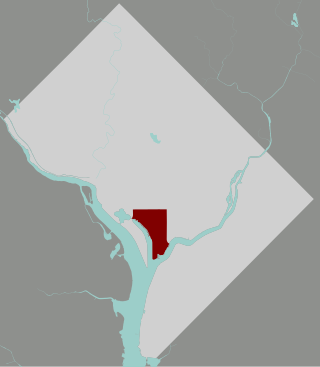
The Southwest Waterfront is a neighborhood in Southwest Washington, D.C. The Southwest quadrant is the smallest of Washington's four quadrants, and the Southwest Waterfront is one of only two residential neighborhoods in the quadrant; the other is Bellevue, which, being east of the Anacostia River, is frequently, if mistakenly, regarded as being in Southeast

The Fort Point Channel Historic District is an historic district located along Congress, Summer and A streets in South Boston on the south side of Fort Point Channel.

Boston Harborwalk is a public walkway that follows the edge of piers, wharves, beaches, and shoreline around Boston Harbor. When fully completed it will extend a distance of 47 miles (76 km) from East Boston to the Neponset River.

Summer Street in Boston, Massachusetts, extends from Downtown Crossing in the Financial District, over Fort Point Channel, and into the Seaport District to the southeast. In the mid-19th century it was also called Seven Star Lane.
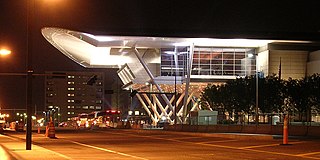
The Seaport District, or simply Seaport, is a neighborhood in Boston, Massachusetts. It is part of the larger neighborhood of South Boston, and is also sometimes called the Innovation District. The Seaport is a formerly industrial area that has undergone an extensive redevelopment effort in recent years. It is bordered by the Fort Point Channel to the west, Boston Harbor to the north and east, and the historic residential neighborhood of South Boston to the south. It is officially referred to by the City of Boston as The South Boston Waterfront. The Seaport District is at risk of climate-related flooding over the next 30 years.
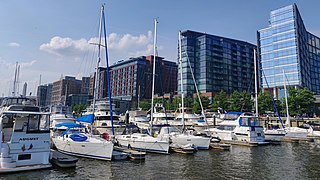
The Wharf, formally The District Wharf, is a multi-billion dollar mixed-use development on the Southwest Waterfront in Washington, D.C. It contains the city's historic Maine Avenue Fish Market, hotels, residential buildings, restaurants, shops, parks, piers, docks and marinas, and live music venues. The first phase of The Wharf opened in October 2017 and the second and final phase was completed in October 2022. The neighborhood encompasses 24 acres of land, 50 acres of water, and contain 3.2 million square feet (300,000 m2) of retail, residential, and entertainment space along 1 mile (1.6 km) of the Potomac River shoreline from the Francis Case Memorial Bridge to Fort McNair.
{{cite journal}}: Cite journal requires |journal= (help)